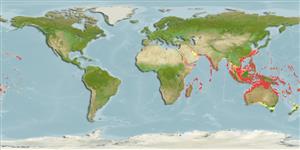Environment: milieu / climate zone / Tiefenbereich / distribution range
Ökologie
seewasser riff-verbunden; standorttreu; tiefenbereich 5 - 210 m (Ref. 9710), usually 5 - 30 m (Ref. 90102). Subtropical; 30°N - 30°S
Indo-Pacific: Red Sea to South Africa, Réunion, Mauritius, Seychelles and Maldives; elsewhere to Indonesia, Japan, Australia and Hawaii; absent in much of Oceania..
Size / Gewicht / Alter
Geschlechtsreife: Lm ? range ? - ? cm
Max length : 21.0 cm TL Männchen/unbestimmt; (Ref. 48636)
Rückenflossenstacheln (insgesamt) : 12 - 13; Rückenflossenweichstrahlen (insgesamt) : 23 - 25; Afterflossenstacheln: 3; Afterflossenweichstrahlen: 17 - 19.
Body shape (shape guide): short and / or deep; Cross section: compressed.
Occur primarily along outer reef slopes, in current channels. Juveniles in aggregations around isolated patch reefs, adults in large schools well above the bottom (Ref. 9710). In Indonesia, adults most common in depth 40-50 m, reported to 200 m (Ref. 48636). Benthopelagic (Ref. 58302). Feed on plankton. Juveniles may act as cleaners (Ref. 9710); also observed in adults (Ref. 48636). Oviparous (Ref. 205). Form pairs during breeding (Ref. 205).
Life cycle and mating behavior
Geschlechtsreife | Fortpflanzung | Ablaichen | Eier | Fecundity | Larven
Form pairs during breeding (Ref. 205).
Myers, R.F., 1991. Micronesian reef fishes. Second Ed. Coral Graphics, Barrigada, Guam. 298 p. (Ref. 1602)
IUCN Rote Liste Status (Ref. 130435: Version 2025-1)
Bedrohung für Menschen
Harmless
Nutzung durch Menschen
Fischereien: nicht kommerziell; Aquarium: Kommerziell
Tools
Zusatzinformationen
Download XML
Internet Quellen
Estimates based on models
Preferred temperature (Ref.
123201): 19.1 - 28.1, mean 26.1 °C (based on 501 cells).
Phylogenetic diversity index (Ref.
82804): PD
50 = 0.5039 [Uniqueness, from 0.5 = low to 2.0 = high].
Bayesian length-weight: a=0.02239 (0.01097 - 0.04568), b=3.01 (2.84 - 3.18), in cm total length, based on LWR estimates for this (Sub)family-body shape (Ref.
93245).
Trophic level (Ref.
69278): 3.3 ±0.40 se; based on food items.
Widerstandsfähigkeit (Ref.
120179): hoch, Verdopplung der Population dauert weniger als 15 Monate. (Preliminary K or Fecundity.).
Fishing Vulnerability (Ref.
59153): Low vulnerability (11 of 100).
🛈
Nutrients (Ref.
124155): Calcium = 50.5 [22.1, 86.5] mg/100g; Iron = 0.82 [0.44, 1.53] mg/100g; Protein = 19.1 [17.9, 20.4] %; Omega3 = 0.209 [0.112, 0.391] g/100g; Selenium = 21.1 [9.6, 44.1] μg/100g; VitaminA = 45 [11, 180] μg/100g; Zinc = 0.755 [0.467, 1.154] mg/100g (wet weight);
